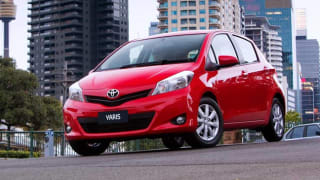
Toyota Yaris 2011 review
The Yaris is one of the favoured children in the Toyota family. The baby Toyota's looks, price and...
Browse over 9,000 car reviews
It is really a matter of horses for courses. What may seem a terribly desirable thing to consumers in one market is going to leave those in another wondering what the fuss is about.
The three bar heater that seems indispensable to the good citizens of Gnome, Alaska, will simply gather dust in a shop window in Bangkok.
And that brings us to the Smart Fortwo. As clever as all get-out in the alleyways of Rome or the backstreets of Paris the little two-seater micro-car elicits less enthusiasm in a wide brown land.
It is not that the ideas are any less clever nor the solutions any less elegant it is just that there is less opportunity to be struck by them.
We have long been a closet fan of the Smart concept — much the same way as one would be a fan of Morris dancing ... there is a certain skill involved but you don't want to actually do it yourself, or let others know that you do.
Drivetrain
The latest Smart close encounter has been with the so-called MHD (that's mild hybrid drive) which really isn't a hybrid at all — at least not as we know it.
The Smart MHD has no electric motors to help it slip quietly away in the mornings, no battery packs soaking up regenerative power from the brakes or pouring additional urge to wheels as the workload increases.
What it does have is a button marked Eco and a nice green light on the dash to make drivers feel good about their efforts to save the planet.
That Eco button does have a function. It engages the stop-start capability of the MHD's dual-mode starter/generator and battery to shut down the three-cylinder, 1-litre naturally aspirated engine as the car is braked to a halt and restart it when the foot is lifted off the brake pedal.
What the off-again, on-again engine means to the environment is a claimed saving of six percent in fuel use — down to 4.7L/100km on a combined cycle — with a similar saving in emissions (112gms of CO2 per kilometre).
For a petrol car they are pretty impressive figures, until you remember that to move the same number of people as any other small sedan you need to use twice as many cars.
Body, fit-out and equipment
And that is probably what makes the Smart such a niche vehicle. It is a selfish car. There is nothing gregarious about it.
Heading off for a game of golf? It's you and your golf bag on the passenger seat. Going shopping? Don't plan on taking a passenger because they are going to have to walk home as an average family shop fills the Smart to overflowing.
The Smart is about satisfying very particular personal needs.
There is no arguing that the car's tiny 2.7-metre length opens up never-before explored options for parking while the fuel-sipping economy is a wallet saver.
It is also one of the better cars in the market for ease of entry and exit. The upright stance makes the seat height/hip relationship very suitable for joints that may not move as well as they once did.
Interior space is also good. That may seem a strange statement given the criticism of the car for its selfish nature but head and shoulder room in the square passenger compartment is surprisingly generous.
There is nothing flash about the car's interior with a small dash display for the speedo, a clock and tacho in two individual pods on top of the dash and materials that are tactile and pleasing.
The seats are supportive and with enough range of movement to get a reasonable driving position from the fixed steering wheel.
Driving
The biggest surprise is just how adequate the performance of the Smart is. With just 52kW of power and a meagre 92Nm of torque it would be fair to assume that the little city car would struggle.
It doesn't. While a 13.3 second 0-100km/h time is not the stuff of excitement the combination of the engine and five-speed automated manual transmission is good enough to handle most needs that arise in city traffic.
The changes are not particularly smooth, especially if the manual selection is used and the engine run out to its peak performance range around 5000rpm.
Ride quality on the 15-inch wheels is reasonably well controled through the McPherson strut front end and DeDion rear axle with coil springs and telescopic shock absorbers.
As good as it is it can't completely isolate the tall body and relatively short wheelbase and narrow track from the laws of physics.
On the open road the claimed maximum top speed of 145km/h is not something any sane person would want to explore but the car will cruise quite comfortable at the speed limit.
However, getting away for the weekend will pose its own problems.
With two people on board the luggage space is — well, restricted. There is a narrow bin behind the seats into which one could squeeze a soft sports bag and suitbag or a couple of briefcases.
The bottom line
A clever concept but as awkward in Australia as a carnivore at a vegan party.
Rating: 70/100
$2,750 - $4,290
Based on third party pricing data
$2,750 - $4,290
Based on third party pricing data